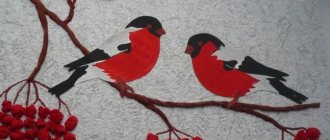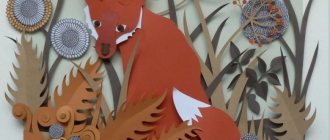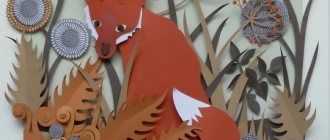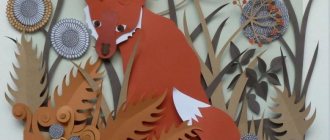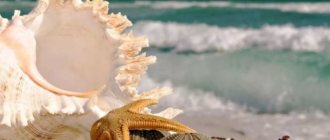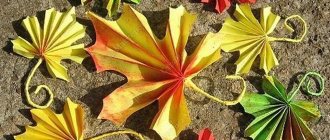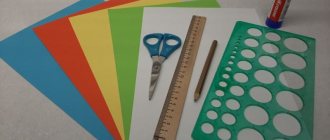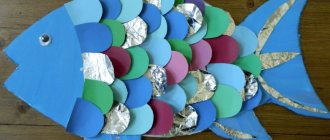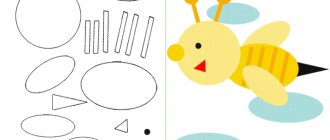Any application that depicts animals, plants, birds is an excellent way to introduce a child to the world around him. Birds are a huge and very significant part of nature, and each of the tens of thousands of species has its own characteristics of plumage, lifestyle, and habits.
Collecting, for example, an applique of poultry in the younger group of a kindergarten is very exciting; it helps introduce children to various representatives of the feathered family.
However, such creativity will be interesting at all ages, so both parents and children will enthusiastically invent new ways of appliqué and come up with unusual, attractive plots.
Bird applications for different age groups of children
The most effective way to show how to work with appliqué is by using the example of poultry - children encounter them most often, if not in real life, then in pictures in books, in alphabet books, on blocks, etc. so it will be easy for even kids to imagine a duck or a cockerel.
To work in the younger group, you should prepare cotton pads, sheets of colored cardboard, plasticine, paints and brushes, as well as glue and scissors with “blunt” tips.
The head or body of a bird is made from a whole disk; disks cut in half will serve for the wings or tail. These parts are glued to the cardboard in the appropriate order and painted. Paws, beak, comb and beard, and eyes are made from plasticine.
A little more complex work can be done in the middle group. To do this, you need to print out images of birds in advance, prepare cotton wool, PVA glue, felt-tip pens and paints.
First, the contours of the body, head, wings and tail are outlined with a felt-tip pen. Then small balls are rolled out of cotton wool and glued inside the outline with glue. When the entire image is filled, the cotton wool can be painted. Parts can also be made from plasticine.
An even more difficult application should be offered to children in the preparatory group. To do this, you will need rooster and hen templates, thick white sheets, paints and brushes, colored paper and napkins of different colors, scissors, a hole punch and glue.
The operating procedure is as follows:
- first you need to paint a white sheet with paints, depicting the sky, the sun, grass on it, and leave it to dry;
- a house, a roof, a fence is depicted on colored paper, after which the details are cut out and pasted onto the dried drawing;
- the cockerel and hen are carefully cut out along the contour on the template;
- napkins are torn into small pieces, from which lumps are rolled up - they can be used to glue the breasts of birds, the head;
- Confetti is prepared from colored paper using a hole punch - circles are glued like feathers on the wings and tail;
- the beard and comb of the cockerel are painted over with red paint;
- The birds are glued to the base.
The joint work of groups of different ages will look great - a large poultry yard made of appliqués made on a large sheet using different methods and materials.
Working on the image of an owl is also perfect for collective creativity. Adults should only draw the body of the bird along with the head on a large sheet of paper.
Each child should be given the task of making a feather for a bird. There is no need to dictate exactly how this should be done - let the children use their imagination. The finished feathers are collected into a tail and glued to the base.
Now you can start decorating the body and head - someone should roll balls of cotton wool or use a hole punch to make confetti from multi-colored paper, someone should stick on the decor, someone would paint the details, someone would sculpt a beak and paws from plasticine.
MAGAZINE Preschooler.RF
Lesson on application (collective composition) “Migratory birds are flying” (Based on the fairy tale by V.M. Garshin “The Frog Traveler”)Goal: To teach children to collectively create a plot based on a familiar fairy tale. Develop a sense of collectivism, create an emotional mood for children.
Tasks:
- Learn to classify birds; exercise the ability to classify birds according to the “wintering-migratory” .
- Develop fine motor skills of the hands, consolidate techniques for using scissors; learn to cut out symmetrical figures of birds from paper folded in half, conveying simple movements (flapping wings), changing the static position of body parts (raised wings).
- To consolidate the ability to show simple semantic connections and spatial relationships between objects when creating a plot.
- Develop aesthetic senses: a sense of shape, size, color, proportions.
- Develop artistic creativity skills, jointly plan upcoming work, and carry out plans together.
- Foster a love of nature and respect for birds.
Material: Frog toy; illustrations for a fairy tale; lake with water lilies; scheme; whatman; duck patterns; sample; sheets of paper, A4 size (white), sheets of colored paper for cutting out ducks; glue; brushes; scissors; colour pencils.
Preliminary work: Conversation about migratory birds. Reading a fairy tale by V.M. Garshin "Frog Traveler" . Looking at illustrations for a fairy tale.
Progress of the lesson:
Educator: Autumn has come... It’s a sad time, it’s starting to get colder, the leaves are falling, the animals are preparing to hibernate, and the birds are flying south.
The birds took to their wings and began to shout in the gloomy sky To a distant land, where it was warm, They flew in a long flock.
“The cold weather is coming,” the birds say with a cry. -We're not flying forever. -We'll be back, we promise.
- Goodbye, dear land: - We're flying away! Let's fly away! Behind the veil of heaven, birds melt in the gray sky.
You and I have read and watched many fairy tales about migratory birds, please name them. Children call fairy tales.
The teacher asks a riddle:
Beauty is a maiden, a master of singing. Lives in a swamp in a green hood,
Eyes are like bowls: Beware, midges!
It is necessary to draw the children's attention to the frog sitting on the water lily. Next, create a game situation by asking the question: What fairy tale did we read about a frog? ( "Frog traveler" ).
- Guys, let's remember who wrote the fairy tale? Did our frog travel alone? What did the frog come up with? What did the frog look like to you? Do you think it will be easy for two ducks to carry a frog?
-That’s right, I think so too, it won’t be easy for two ducks to carry a frog. How can we help? What can we do? That's right, let's cut out a whole flock of ducks like these from paper and glue them onto the panel.
Exercise “Guess, sit down and clap”
- Guys, now I will name migratory and wintering birds, if you hear the name of a wintering bird, then sit down; and if the name is migratory, then clap your hands. Crow, nightingale, woodpecker, magpie, dove, swallow, tit, rook, starling, bullfinch, stork, crane, sparrow, heron, ducks, etc.
Educator: Look how we will cut out ducks. Fold a sheet of paper in half so that the fold line is located at the bottom. We apply the template close to the fold line, trace it with a pencil and cut out the duck along the contour. Next, we cut the wings and tail with scissors or use our fingers to make it look like feathers. The eye and beak can be completed.
- Guys, tell me how to glue the duck so that it can be seen that it flies and flaps its wings?
After the children answer, show two options for gluing the duck:
A. the entire body, except the wings, is glued to the background;
b. the body and one wing are glued to the background.
Fizminutka
A flock of birds flies south, the sky is blue all around. (Children wave their arms like wings.) In order to fly faster, you need to flap your wings. (Children wave their hands more intensely.)
Independent work of children. Remember safety precautions when working with scissors and glue. Individual assistance if necessary.
Educator: Guys, show the ducks what kind of ducks you got. Now glue them to the “sky” so that you get a flock. The ducks should fly in one direction and not interfere with each other. And don't forget that ducks flap their wings.
- Guys, now let's remember when the frog flew with the ducks across the sky, what did she see below? What were they flying over? And when the frog flew with the ducks across the sky, what did everything on earth seem like to her?
So guys, look what a beautiful picture we have. What worked best or what didn't work out? What was the most interesting part of the lesson? Did you like the lesson or not? Did you get an emotional charge or not? Did you learn something new or not? Thank you for your work and helping the frog!
| Next > |
Paper bird applications
There are many options that depend on the child’s age, abilities and desire to follow a certain procedure. A little help from adults will, of course, be needed, but in general children can do a lot on their own.
You should also not limit their imagination if somewhere they want to deviate from the planned plan - after all, this is creativity, and it does not always fit into the framework.
Arrival of birds
A very appropriate theme for spring, and the craft is as simple as possible:
- green (blue) cardboard for the base is prepared;
- white paper is cut into strips - these will be birch trunks; horizontal lines should be applied to them with a black marker along the entire height in different places;
- a birdhouse is cut out of brown paper, the window in it can be made of black paper, or painted with black paint;
- birch leaves are cut from green paper;
- the birds are cut out according to a template and painted (or decorated with cotton balls, confetti, beads, etc.);
- Now all the details are glued onto a cardboard base: first the birch tree trunks, then the birdhouse, followed by the leaves and, finally, the birds.
The missing parts can be painted on or made from plasticine.
Dining room for the birds
Once you start with appliqué, it may be difficult to stop, and you may end up making a real bird feeder. But first, it’s worth getting your child interested in a three-dimensional appliqué of birds on a paper feeder.
A sheet of white cardboard is prepared. Using the “wet” watercolor method, you can apply the blue sky and thawed patches in the snow to it. By the way, if you take initially blue cardboard, you can simply spray the snowball by dipping a hard brush or an old toothbrush into diluted white gouache. And paint on the snowdrifts.
While the paints are drying, cut out tree trunks from brown paper and add a few branches. It would be best to glue the feeder from corrugated cardboard.
You can cut out birds for applique from colored paper according to the template, outlining the contours of the wings, beaks and eyes. The figures are glued to the base - everything is ready!
Swallows on wires
For this work you will need gray woolen thread (twine will also work), white, yellow and black paper, blue cardboard, glue, white felt-tip pen (you can take a proofreader), scissors.
The blue cardboard is unfolded with the wide side down. From edge to edge horizontally, through the middle of the sheet, two threads are pulled and secured with glue on the back side of the base.
Strips 8-10 cm long and 3 cm thick are cut from white paper. Strips of the same thickness should be cut from black paper, but they should be 15-16 cm long, and the lower edge should be thicker. It is cut into a dovetail shape.
You also need to cut out wings from black paper (a curved strip with tapered tips, resembling the open wings of a swallow in shape), and from yellow paper - small squares that fold diagonally - these are the beaks of birds.
Now you should assemble the parts sequentially: the black strip is glued in the middle to the “wire”, tail down, its upper part is folded forward, and the edge is glued to the tape - you get a bird’s head. The wings are glued a little lower.
The white ribbon is folded into a ring, the edges are glued together, after which it is attached under the head of the bird - this is the breast of a swallow.
The beak is glued to the head, and eyes are drawn above it with a white felt-tip pen (corrector).
Paper palms
You can create an impressive craft even without a bird stencil for applique - you will only need multi-colored paper, white cardboard (A3), glue, scissors, pencil, felt-tip pens and decor.
In the middle of the white sheet, closer to the bottom edge, the body of the bird along with the head is drawn. You can only outline the wings and outline everything with a black felt-tip pen (or any bright, saturated color).
You need to trace the child’s palm on colored paper and repeat on several sheets of different shades. Cut out and glue the back of the bird like a fan - this will be the tail.
Now you can give free rein to your imagination: for example, outline the glued-on palms with a liner, glue the body of the bird with cotton balls and color them, draw the eyes and beak or cut them out of paper and stick them on.
You can use sequins, gold leaf, beads, confetti, threads and much more for decoration.
Feather birds
Feathers also make great bird crafts! For example, a craft made from a pine cone, paper and feathers will be an excellent interior decoration.
In order to make such a craft, we will need:
- Cone;
- Multi-colored feathers;
- Thick paper for making the head and paws;
- Glue gun.
Before starting work, the pine cone must be dried in the oven for 20-30 minutes. This will get rid of excess moisture and insects inside.
The dried cone can be painted with paints, or you can leave the natural color and texture. We glue the cut out parts of the paws to the bottom of the cone, and also glue the head to the pointed end of the cone. You can glue toy eyes to your head, or you can draw them yourself. Now all that remains is to attach the feathers. We carefully place them on glue. The more feathers there are, the more magnificent the bird’s “hair” will be.
Related article: DIY book stand made of plywood and wire
There is also another way to make a bird from feathers.
We will need:
- 2 sheets of cardboard (white and any color);
- Glue;
- Scissors;
- Feathers.
Cut out the silhouette of a bird from white cardboard. In our case, this is the firebird. The silhouette, starting from the tail, must be covered with feathers. You can stick them on top of each other. Then we glue the cutout with feathers to colored cardboard. The painting can be framed and will be a great decoration for any room in your home!
Bird leaf appliques
It is very convenient to use natural materials for applique - in the fall, leaves of different colors, ironed or stored in a book, are perfect for this. You will also need to prepare blue cardboard, white and yellow paper, glue, scissors and plasticine.
You can use any cardboard - simple, metallized, velvety, with a print.
A dense green leaf is glued in the center of the leaf; it should be oval in shape and without damage. To press and smooth the leaves, you can use a dry and clean cloth.
The beak is cut from a red or burgundy leaf; a bird's crest can be cut from a leaf of a brighter shade.
Now you need to cut a large maple leaf in half and glue the halves on both sides of the body, like wings. On top of them you need to stick the same halves of leaves, only smaller in size.
The tail can be made from several leaves of suitable color, shape and size, also arranged in a fan shape and in 2-3 layers.
Clouds are cut out of plain white paper, and a sun is cut out of yellow paper, after which these parts are glued onto the base.
Leaf craft
Making a firebird from leaves is not at all difficult, just take:
- Dry leaves;
- Glue;
- Paints;
- Glue gun;
- Cardboard for the base.
The first step is to prepare the cardboard for the base. You can paint it the color you want or choose a pre-colored one.
Next, prepare the leaves for the tail. To do this, select leaves that are suitable in color and shape, carefully place them on paper, paint each leaf with paint, and leave them until completely dry.
When the paint on the leaves has dried, glue them to the base. Apply a thick layer of hot glue to the cardboard, and also put dots on each leaf so that it sticks well. We lay the leaves on the cardboard as intended and press well. You can use a napkin to remove excess glue.
It's important to remember that hot glue hardens very quickly, so if there are visible marks left, you can paint them with the same paint as the leaves to help the colors blend together.
The next step is to create the body of the bird. For it you will need a dry leaf, different in color from the ones we chose for the tail. We glue it on top of the tail, and also press it tightly with a napkin so that the body sticks well to the leaves.
Related article: Raglan knitting on top: master class on raglan knitting for children, patterns and description of a beautiful model for women
Cut out the legs and eyes from a dark piece of paper or cardboard and glue them to the body of the firebird.
Volumetric applications of birds
The simplest methods for making volumetric appliqué were discussed above. With an understanding of how you can make interesting pictures using glue, paper and cotton wool, comes the desire to experiment with other materials. However, paper can offer many options.
For example, tear-off appliqué perfectly develops motor skills, perseverance and imagination. You can draw a bird (or several birds) yourself, or you can trace it using a stencil, or cut out a template.
The plumage is created using small pieces of colored paper.
You can add trees to your work (the trunks are made not from simple strips, but from strips twisted into a tube and glued together, from plastic tubes, from thick threads and ropes, etc.), a colorful landscape as a background, to create a nest using the weaving technique, etc. d.
Plasticine is great for creating three-dimensional works. True, it will be difficult for very young children to cope with this material without adults, but the older group will cope with plasticine appliqué of birds on branches with pleasure. Here is an example of such work.
Take a sheet of black or dark blue cardboard - a round or oval shape will be original and attractive. Flagella are made from brown plasticine, several of which are attached together to a base - these are tree trunks. Branches are added from the same flagella.
Two large circles (the body of the birds) and two smaller circles (the heads) are cut out of velvety gray or light brown paper.
Yellow eyes, black pupils and a yellow beak are molded from plasticine. Feathers can be made using any technique - from cotton balls, scraps of paper, thread, etc. Wings can be cut out of paper, or they can be molded from plasticine and the feathers treated with a special stack.
A cotton pad is glued to the top of the composition - this is the moon. Reflections of moonlight can be shown by outlining all objects with a light outline (blue, soft white) - paint or a felt-tip pen can be used only in some places, it will be more reliable.
To create three-dimensional works, you can use plasticine flagella, buttons, beads and seed beads, nut shells, corks and caps, shells, cereals, and much more.
Bird applications using quilling technique
One of the most interesting techniques for creating three-dimensional paper appliqué. These are rolled paper strips that can be shaped into circles and droplets.
By varying the width of the ribbons, the thickness of the twist, the sizes of individual elements and, of course, colors, you can create paintings that are completely different from each other each time - even if you take a finished work you like as an example.
The name itself translates from English as bird feather, which is great for bird appliques. You can involve not only children, but also adults in the process by creating a Firebird - colorful, alluring, magical.
To work, you need double-sided colored paper - you need to cut thin long strips from it using a ruler and a stationery knife. However, many specialized stores sell ready-made kits.
For a fairytale bird you need red, orange, burgundy, and golden shades. For the background you need to stock up on cardboard and beautiful paper. You also cannot do without a pencil and eraser, scissors and white paper. To twist, you can use a regular toothpick (skewer).
The cardboard base is covered with beautiful paper. Although you can paint the cardboard yourself, or simply paint it. You should draw a sketch of the future work on a separate sheet so as not to get confused in the placement of parts.
Yellow and orange stripes are twisted; they will be used to decorate the head, beak and some places on the body. After this, you should try on the parts on the sketch and glue them together. The voids can be left as is for now, or you can twist a few more elements and fill the gaps.
Yellow and golden paper will become the basis for the feathers. It is easier to cope with this task if you have templates of different sizes. The edges of the feathers must be cut into fringes. The parts for the wings need to be folded in half; for the tail elements this is not necessary.
The top of the wings will be decorated with curved strips; for strength, three parts should be glued together.
Now the assembly of the Firebird applique begins on the basis. The body is glued, the base for the wings is attached to it - it should immediately be bent to shape. Now it’s the turn of the feathers, including the tail ones.
A fringe is cut out of golden paper and glued under the bird's neck. The crest on the head is made in the same way. Now the twisted elements are glued onto the feathers. When working, you should adhere to the greatest possible realism of the image.
Choosing the most suitable application technique for yourself is easy. This type of creativity is extremely attractive; once you have mastered the basics, you will be able to create entire canvases with a variety of subjects and characters.
In addition to the fact that children learn about the world with the help of applications, it also contributes to closer communication with parents, the development of motor skills, and the relief of emotional stress.
Lesson on application on the theme “Birds”
When compiling notes, it is worth planning the main stages of the lesson:
- organizational stage: greeting children, getting them into a working mood (1 minute);
- motivational stage: interest children and lead them to determine the topic of the lesson (5 minutes);
- explanation: show children what and how they should do, distribute materials for the lesson (5–7 minutes);
- independent work: children are busy with appliqué (20 minutes);
- final part: summing up, demonstrating the resulting work to the whole group (3–5 minutes).
In the middle of the lesson, do not forget to take a dynamic break for the children to rest, but the warm-up can be compared with the topic of the lesson (for example, when studying the topic “Birds”, read a poem about birds and perform physical exercises for it: jumping, flapping their “wings”, etc. )
Table: lesson notes on application on the topic “Fairytale Birds”
| Purpose of the lesson | Strengthen the ability to cut out the image of a fairy-tale bird, notice its characteristic features in contrast to real birds, teach how to stick on figured decorations. |
| Materials and equipment | Landscape sheet, colored blanks of square, rectangular, triangular shape, colored strips, colored feathers, pencil, scissors, glue, brush, napkin. The materials are prepared in advance and laid out on the tables. |
| Game motivation | Educator: Guys, today we will take a trip to a fairyland where fabulous birds live. Let's remember which fairy tale tells about such a bird, and who caught it. Children: Ivan Tsarevich and the gray wolf. Educator: Let's look at the illustrations for this fairy tale. (the teacher shows pictures of exotic tropical birds, the children look at the color of their plumage and tell how they look like a fairy-tale bird). |
| Explanation | Educator: Now please describe to me the fairytale bird (firebird), what is it like? The children answer. The teacher tells how to make an applique: The head and body are cut out from round and rectangular blanks. The body of the bird can be drawn on the back of colored paper and cut out. We will make wings and a tail from triangles, making zigzag or wavy cuts along the edge. (the teacher places the main details on the sheet and sticks them on). To make decorations for the head, wings and tail, you need to take a colored strip and fold it in half several times or like an accordion. On the top part, draw a circle, or an oval, or a droplet-shaped figure, and cut it out. Decoration elements can be of different sizes, colors, shapes. They can be glued on top of each other. Glue shaped decorations on the wings, tail, head, you get a fairy-tale bird. |
| Physical education minute | Here on the branches, look, (children clap their hands on their sides) There are bullfinches in red T-shirts. (show the “aprons” on their chests) They spread their feathers, (move their arms slightly to the sides) Bask in the sun (lightly move their fingers, shake their hands) They turn their heads, turn them, (turn their heads to the right and left) They want to fly away. (run in a circle, waving their arms) Shoo! Shoo! They flew away. (children smoothly return to their seats) |
| Independent work | Children perform applications under the guidance of a teacher. |
| Didactic game “Who Flew Away” | The teacher shows pictures of birds for a few seconds and then closes them. Children must name the birds. Then the teacher removes one picture, and the children must name which bird is missing. |
| Summarizing | Discussion of works, organization of an exhibition, reflection on the questions “what was difficult”, “what did you like”. |
| Source | Shabrova Olga Alexandrovna. https://nsportal.ru/detskiy-sad/applikatsiya-lepka/2013/09/21/konspekt-nod-khudozhestvennoe-tvorchestvo-applikatsiya-v |
